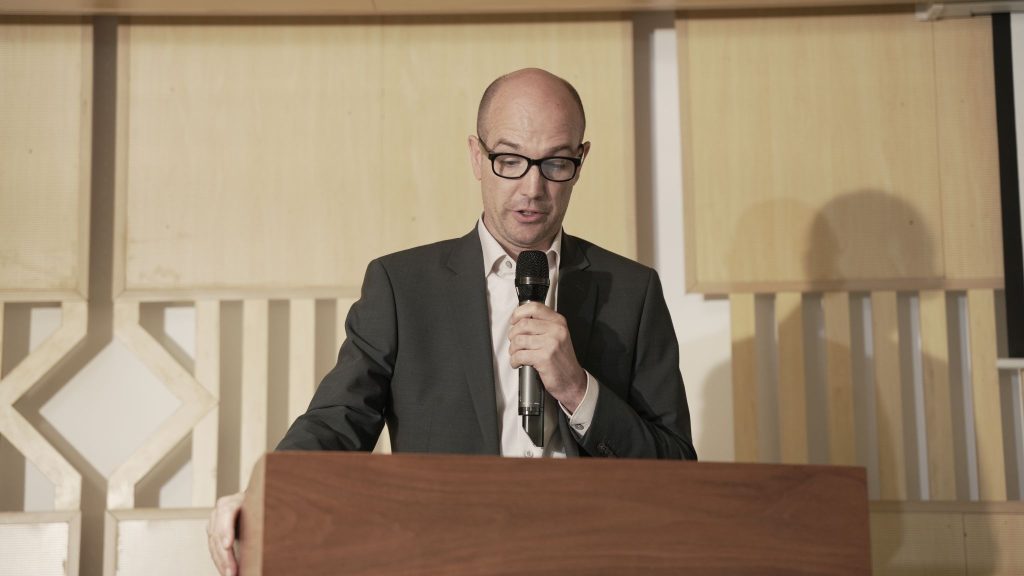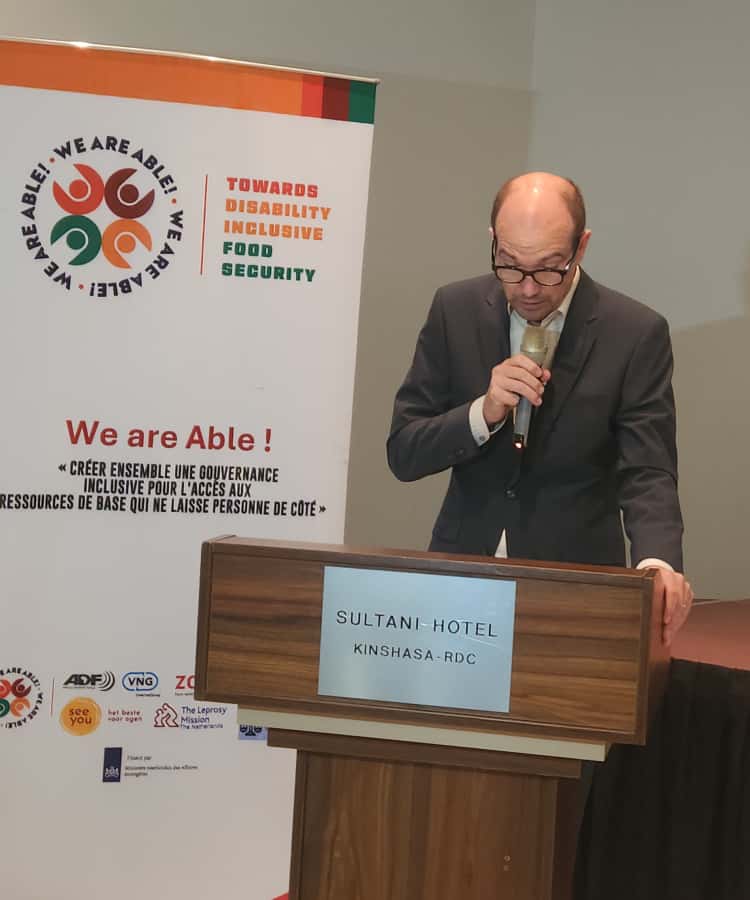The We are Able! (WaA!) programme has brought about significant and lasting change in promoting disability inclusion across various communities. In an interview with WaA!, Erni van Wingerden, Program Team Coordinator at The Leprosy Mission, mentions how in the last five years, the WaA! programme has grown stronger by strengthening local Organisations of Persons with Disabilities (OPDs) to effectively advocate their rights and showing tangible commitment by adapting and implementing inclusive policies.

Q: Looking back since the WaA! programme’s inception, how would you describe the progress over five years made toward its three core goals?
Our goal was to change norms, policies and practices and making food security systems more inclusive. In the WaA! implementation areas I visited, and through the reporting, I have seen many positive changes. The changes, in particular, in the local implementation areas, were often beyond expectation. OPDs became much stronger in voicing their needs and rights and local authorities and national government commitment towards disability inclusion was confirmed by implementation of existing policies, adjusting policies and development of new policies. Our direct implementation partners mention that the impact of WaA! after five years is bigger than what they have seen in any other project of similar length. I heard many testimonies of partners and beneficiaries who mention that their communities became more inclusive, not only related to food security, but among others also more inclusive education, employment, healthcare, finance and religious communities.
Q: How has the strengthening the voice and inclusion of persons with disabilities lead to stronger OPDs and improved food security policies?
The WaA! programme catalyzed a transformation in OPDs, they became much stronger through capacity building and leadership development. OPDs were trained in governance, advocacy and organisational management, and were placed in charge of their own capacity strengthening. At the same time increased membership, through community mobilisation, resulted in broader representation, especially in rural areas. Creating networking and platform opportunities and e.g. public private partnerships enabled OPDs to collaborate with government, NGOs and private sector actors. These efforts led to OPDs becoming legitimate, capable and influential entities at both local and national levels, with the ability to lead their own agendas and engage meaningfully with public authorities and foster policy change.
Q: What do you consider to be the most significant achievements of the WaA! project so far, and how have these impacted persons with disabilities?
Personally, I consider it most significant that norms and practices within communities became more inclusive, this was supported by policy implementation and attitude changes through awareness. This awareness in communities for all community stakeholders created significant change in the WaA! implementation areas. The voices of persons with disabilities are now heard in the many places where the project is implemented. In addition, participation in decision making increased leading to Local Inclusion Agendas (LIA). In many communities, we have seen stronger representation of organisations of persons with disabilities who by claiming their rights and voicing their needs managed to reduce barriers. In many places, advocates and ambassadors for inclusion can be found and, not only in the position of Disability Inclusion Facilitators (DIFs) but also among a variety of citizens, local authorities, Civil Society Organisations (CSOs), religious leaders, private sector actors, etc.
For me, the Disability Mainstream Committees (DMCs)in Ethiopia are a great example of how inclusion can be promoted and achieved. I hope that DMCs will be active throughout Ethiopia, with the same effectivity and the same results, or even better, than we have seen in the WaA! implementation areas in Ethiopia.
Q: What were the major challenges the project encountered during implementation, and how were these challenges addressed or overcome?
The work was sometimes arduous and there were indeed many challenges on the road that we encountered. We started this project under challenging circumstances during the Covid pandemic, there were conflicts, natural disasters and economic and political challenges. Consortium partners and implementing partners also faced various challenges, different ways of working had to be aligned and or differences in vision needed to come together, e,g., as to how to implement the project in the most impactful way. And then there were multiple budget challenges, the multi stakeholder budgeting processes were at times complicated. Yet, we kept on working in consortium on our key objective — more inclusive food security systems.
The work we do as The Leprosy Mission also entails working for persons affected by leprosy, and while having been treated, most persons affected by leprosy, in some of the WaA! implementation areas have had to deal with stigma and many live with disabilities. The stigma related to leprosy is deep rooted, because of fear, misinformation, cultural beliefs and systemic neglect. Addressing this through community awareness was a first crucial step to make, before addressing food security issues. Through a multi-partner (community, authorities, OPDs and CSOs) awareness campaign we could report that persons affected by leprosy, previously excluded, could get access to water, land and right to inheritance. Inclusion of their organisations in OPD networks further strengthened their position and removed barriers for them.
As TLM we always tried to think along in a cooperative and constructive way, searching for practical solutions, trying to communicate in an open and honest way, expressing what we can contribute to solutions and sometimes what we cannot contribute. Confronted with challenging situations I found this cooperative willingness throughout the consortium; this made it a privilege and pleasure to work with all the colleagues and partners in the various organizations and countries.

Q: What has been the particular role of the DIFs in some of the countries towards achieving the successes of this project?
Disability Inclusion Facilitators (DIFs) were working in all six WaA! countries, through the interventions of SeeYou Foundation, Light for the World and The Leprosy Mission. DIFs played a crucial role in the success of the WaA! project by acting as community-based advocates and connectors for persons with disabilities. Through their efforts, DIFs have raised awareness about disability rights, advocated for the inclusion of persons with disabilities in decision-making, and mobilised communities to support inclusive food security programs. Their work, in cooperation with other implementation partners, has led to tangible changes, such as integrating persons with disabilities into agricultural cooperatives in Burundi, accessible water points in Ethiopia, changing customary practices and restoring people’s rights on heritage in Uganda, DR Congo and other countries and securing land rights for women with disabilities in Burundi and DR Congo. DIFs’ lived experience and strong community engagement have fostered trust and legitimacy, resulting in greater participation and access to resources for persons with disabilities. While their impact is widely recognised, the sustainability of their contributions depends on formal integration into local systems. Despite the closure of the project we already found >85% of the DIFs expressed the willingness to continue their work to some extent, even without any project funding. Interestingly, OPD representatives and WaA! staff indicated that less DIFs would continue their work.
Read more about this in the Policy paper: Insights in effectivity and sustainability of Disability Inclusion Facilitators.
Q: From your perspective, what are the key outcomes or lasting changes that the WaA! project has generated, and what do they mean for future initiatives on CSO strengthening and Lobby & Advocacy?
I already mentioned some key outcomes previously, e.g. DMCs, in addition to this, we have seen many local policy changes but also some national policy changes and / or existing and new policies being implemented. Through WaA!, we have seen stronger participation and representation of OPDs in decision making. The lobby and advocacy power of OPDs may enhance the chances of successful lobby and advocacy. However, much also depends on the willingness of governments and resources available for the general public and for persons with disabilities in particular. Allocating resources is one of the essentials to promote, maintain and expand our efforts to remove barriers.
Q: How was your experience of attending the country closure events in September in BDI, DRC and ETH?
I have had the privilege of being involved almost from the start of the development of the project in 2020. Attending the closure events and seeing the impact we created for so many individuals makes me feel proud, I enjoyed listening to the many testimonies in the three countries, both from persons with disabilities themselves, their representatives and authorities (live and via the short videos made). For me, these testimonies were the highlight of the meetings as through these testimonies the results and impact on improved food security for persons with disabilities became visible.
While attending the closing events I was also feeling a bit sad as this beautiful project is coming to an end and we cannot extend the project as it is now. It was, however, clear that the many learnings will be used for follow-up and/or expansion interventions, some of which have already started and some that are now in development.
In all of the closing events Burundi, DR Congo and Ethiopia both OPDs, CSOs, authorities and others expressed commitment to continue to work with and for persons with disabilities. The attendance of representatives of diverse ministries from respective countries and the presence of representatives of the Ministry of Foreign Affairs of the Netherlands and / or Embassy was appreciated in the closing events. Throughout the closing events, showcases of the impact created and sustainability approaches were shared.